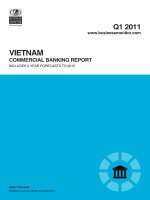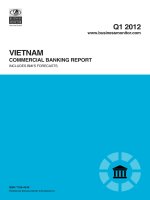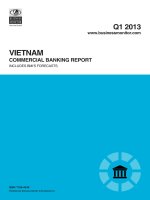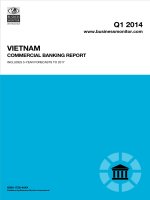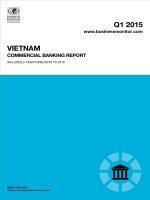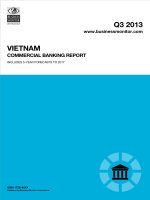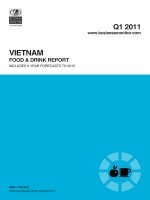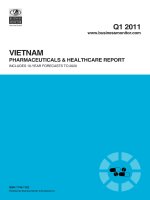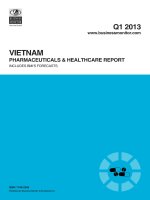Vietnam freight transport report q1 2013
Bạn đang xem bản rút gọn của tài liệu. Xem và tải ngay bản đầy đủ của tài liệu tại đây (482.13 KB, 58 trang )
Q1 2013
www.businessmonitor.com
VietnaM
freight transport Report
INCLUDES BMI'S FORECASTS
ISSN 1750-5364
Published by Business Monitor International Ltd.
VIETNAM
FREIGHT TRANSPORT
REPORT Q1 2013
INCLUDES 5-YEAR FORECASTS TO 2017
Part of BMI’s Industry Report & Forecasts Series
Published by: Business Monitor International
Copy deadline: November 2012
Business Monitor International
85 Queen Victoria Street
London
EC4V 4AB
UK
Tel: +44 (0) 20 7248 0468
Fax: +44 (0) 20 7248 0467
email:
web: www.businessmonitor.com
© 2013 Business Monitor International.
All rights reserved.
All information contained in this publication is
copyrighted in the name of Business Monitor
International, and as such no part of this publication
may be reproduced, repackaged, redistributed, resold in
whole or in any part, or used in any form or by any
means graphic, electronic or mechanical, including
photocopying, recording, taping, or by information
storage or retrieval, or by any other means, without the
express written consent of the publisher.
DISCLAIMER
All information contained in this publication has been researched and compiled from sources believed to be accurate and reliable at the time of
publishing. However, in view of the natural scope for human and/or mechanical error, either at source or during production, Business Monitor
International accepts no liability whatsoever for any loss or damage resulting from errors, inaccuracies or omissions affecting any part of the
publication. All information is provided without warranty, and Business Monitor International makes no representation of warranty of any kind
as to the accuracy or completeness of any information hereto contained.
Vietnam Freight Transport Report Q1 2013
© Business Monitor International Ltd
Page 2
Vietnam Freight Transport Report Q1 2013
CONTENTS
BMI Industry View ............................................................................................................................................ 5
SWOT Analysis ................................................................................................................................................. 7
Vietnam Freight Transport SWOT ......................................................................................................................................................................... 7
Vietnam Political SWOT ........................................................................................................................................................................................ 8
Vietnam Economic SWOT ...................................................................................................................................................................................... 9
Vietnam Business Environment SWOT................................................................................................................................................................. 10
Industry Trends And Developments ............................................................................................................ 11
Maritime ................................................................................................................................................................................................................... 11
Multimodal................................................................................................................................................................................................................ 12
Rail ........................................................................................................................................................................................................................... 13
Road.......................................................................................................................................................................................................................... 13
Market Overview ............................................................................................................................................. 14
Industry Forecast ........................................................................................................................................... 19
Macroeconomic Outlook ........................................................................................................................................................................................... 19
Road Freight ............................................................................................................................................................................................................. 19
Table: Road Freight, 2010-2017.......................................................................................................................................................................... 19
Rail Freight............................................................................................................................................................................................................... 20
Table: Rail Freight, 2010-2017 ........................................................................................................................................................................... 20
Air Freight ................................................................................................................................................................................................................ 20
Table: Air Freight, 2010-2017 ............................................................................................................................................................................. 21
Maritime And Inland Waterways .............................................................................................................................................................................. 21
Table: Maritime Freight, 2010-2017 ................................................................................................................................................................... 21
Table: Inland Waterway Freight, 2010-2017 ....................................................................................................................................................... 22
Trade ........................................................................................................................................................................................................................ 22
Table: Trade Overview, 2010-2017 ..................................................................................................................................................................... 22
Table: Key Trade Indicators, 2010-2015 ............................................................................................................................................................. 23
Table: Main Import Partners (US$mn), 2002-2009 ............................................................................................................................................. 24
Table: Main Export Partners (US$mn), 2002-2009 ............................................................................................................................................. 24
Global Oil Products Price Outlook ............................................................................................................... 25
Table: BMI's Refined Products Forecasts............................................................................................................................................................ 26
Table: Middle East Outperforms In Terms of Passenger Growth ........................................................................................................................ 30
Political Outlook ............................................................................................................................................. 35
Domestic Politics ...................................................................................................................................................................................................... 35
Long-Term Political Outlook .................................................................................................................................................................................... 38
Macroeconomic Outlook ............................................................................................................................... 41
Table: Vietnam – Economic Activity, 2011-2016 ................................................................................................................................................. 43
Company Profiles ........................................................................................................................................... 44
Vietnam Airlines .................................................................................................................................................................................................. 44
Vinatrans ............................................................................................................................................................................................................. 46
Vietnam National Shipping Lines (Vinalines) ...................................................................................................................................................... 48
Vietnam Demographic Outlook ..................................................................................................................... 51
Table: Vietnam's Population By Age Group, 1990-2020 ('000) ........................................................................................................................... 52
Table: Vietnam's Population By Age Group, 1990-2020 (% of total) .................................................................................................................. 53
© Business Monitor International Ltd
Page 3
Vietnam Freight Transport Report Q1 2013
Table: Vietnam's Key Population Ratios, 1990-2020........................................................................................................................................... 54
Table: Vietnam's Rural And Urban Population, 1990-2020 ................................................................................................................................ 54
BMI Methodology ........................................................................................................................................... 55
How We Generate Our Industry Forecasts .......................................................................................................................................................... 55
Transport Industry ............................................................................................................................................................................................... 55
Sources ................................................................................................................................................................................................................ 56
© Business Monitor International Ltd
Page 4
Vietnam Freight Transport Report Q1 2013
BMI Industry View
We do not envisage a strong pickup in Vietnamese exports due to growing evidence of a lacklustre
recovery in global demand in 2013, which will have a knock-on effect on the country's freight industry.
Additionally, Vietnam's main export partners, the US, China and Japan, are all finding it hard to shake off
the economic hangover of 2012. That said, Vietnam's economy remains on track for a robust recovery in
2013, and we view consensus estimates on growth as being overly pessimistic. Also, looking at the
breakdown of exports, we are seeing encouraging evidence that Vietnam is becoming less reliant on
refined crude imports (dominantly petroleum imports) and could soon become a net exporter of crude oil
over the coming years.
By mode, the largest growth is set to occur in the maritime sector, with the country's biggest port, Ho Chi
Minh City, set to enjoy year-on-year (y-o-y) growth of more than 7.50% in 2013. Air and road freight
sectors will both see annual growth of more than 6% this year, while propping up the freight mix will be
rail.
There are encouraging signs that China is seeking to strengthen ties with its Asian neighbours, providing
a boost to infrastructure. The Yuxi-Mengzi railway line, which will start operating in Q412 and was
funded by Chinese investment, will eventually run between the Yunnan province in China and Laos,
Singapore, Thailand and Vietnam. Vietnam still suffers from a significant deficit in transportation
infrastructure, and we believe the Vietnamese government will continue to develop this sector over the
medium term.
Headline Industry Data
2013 rail freight tonnage is set to increase by 3.12% to 8.71mn tonnes.
2013 air freight tonnage is forecast to rise by 6.06% to 220,620 tonnes.
Tonnage handled at the Port of Ho Chi Minh City in 2012 is forecast to grow 7.56% in 2013,
whereas tonnage handled at the Port of Da Nang is forecast to increase 4.33%.
2013 road freight tonnage is forecast to grow by 6.85% to 713.01mn tonnes.
2013 total trade is forecast to rise by 5.70%.
Key Industry Trends
Vinalines' Woes Continue
We believe that Vietnam National Shipping Lines' (Vinalines) losses sustained in the first half of 2012
are largely due to the twin factors of corruption and financial mismanagement. Although the shipping
sector has been hard hit by global economic headwinds in recent times, Vinalines' heavy exposure to
© Business Monitor International Ltd
Page 5
Vietnam Freight Transport Report Q1 2013
Vietnam's domestic transport sector, which has been performing well recently, indicates that the
company's struggles go beyond the troubles facing the global industry.
Dachser Builds Presence In Vietnam With Joint Venture
Dachser, a Germany-based logistics company, has taken another step towards expanding its operations in
the Far East by creating a new Vietnamese operation, which has branch offices in Ho Chi Minh City and
Hanoi, reported Handy Shipping Guide in October. The Hong Kong arm of Dachser, Dachser Far East,
will be the major shareholder in the new joint venture with Dachser Vietnam to provide freight
forwarding and logistics. The company currently operates in nine Asian countries.
Chinese Rail Investment Boosts Vietnam
Vietnam should benefit from the news that the 141km line from Yuxi to Mengzi, China, was completed
on August 14, 2012, linking China to the Vietnamese border in the near future. The new route, which is
primarily going to focus on rail freight, was funded jointly by the Chinese Ministry of Railways and
Yunnan province at a cost of CNY4.5bn, with services expected to begin by the end of 2012.
Key Risks To Outlook
We note that the trend of interest from major freight companies in the intra-Asia market, first seen in the
container shipping sector, is now picking up pace in the air cargo market. Air China Cargo, the freight
subsidiary of Air China, is reportedly preparing to launch a cargo service linking China with Vietnam,
the airline's second cargo venture into Asia in 2012.
According to Air China Cargo's chief operating officer, Titus Diu, the carrier is to launch an all-cargo
service in Q312 linking Shanghai with Ho Chi Minh City in Vietnam via Singapore, followed by a direct
flight back to Shanghai.
Although we expect Vietnam's economy to perform well over the short term – indeed, we are maintaining
our view that real GDP growth will come in strong at 7.0% in 2013, and believe that signs of an
improving economic outlook over the coming months will soon reignite bullish sentiment towards
Vietnam's growth prospects – external factors do have a big bearing.
With the US by far and away Vietnam's largest export partner, the Asian country's fortunes are very much
intertwined with the global superpower. It will come as a negative then that we maintain our 2.0% real
GDP growth forecast for the US for 2012 and our 2.1% projection for 2013. The economy is running
dangerously close to 'stall speed', by which we mean that any major unanticipated headwind would be
enough to push the economy into recession. The knock-on effect on Vietnam's freight industry would
therefore be detrimental, as demand slows.
© Business Monitor International Ltd
Page 6
Vietnam Freight Transport Report Q1 2013
SWOT Analysis
Vietnam Freight Transport SWOT
Strengths
Weaknesses
Opportunities
Threats
Vietnam's strong domestic growth rate, coupled with its geography – it stretches for
thousands of kilometres on a north-south axis, creating a need for long-distance
freight haulage.
Recovery of the nation's ports in 2010 is expected to continue over the mid-term to
2016.
Vietnam's location on the South China Sea gives the country access to the main interAsian shipping routes, as well as access to the developing land transport links with
ASEAN countries, allowing the country scope to develop its trade logistics.
The generally poor state of the road network. Despite new highway construction, only
13.5% of the network is considered to be in good condition. Just 26% of the network
has two or more lanes and only 29% is tarred.
Traditionally low investment in rail, with the potential for cost-effective bulk rail freight
being underutilised.
Decades of under-investment have left the country with a port infrastructure system
that is poor by international standards. Overcapacity is therefore a growing problem.
The beginnings of local commercial vehicle production, which will help improve the
stock of lorries used by road haulage companies.
Chinese investment could bring about much needed improvements in the rail sector.
Growing international interest in Vietnam as a growth market within the box shipping
sector.
Vietnam risks losing out to neighbouring countries if it is unable to develop its
infrastructure to keep up with the pace of demand.
Vietnam is vulnerable to any slowdown in Chinese investment. Indeed, the Chinese
government issued a warning to foreign shipping companies operating in the South
China Sea in mid-April 2012, following an incident which saw the Philippine navy
frigate Gregorio del Pilar involved in a stand-off with two Chinese surveillance vessels
after it had intercepted Chinese fishing vessels traversing the region.
A drop in international demand for exports would negatively affect Vietnam's freight
transport sector.
© Business Monitor International Ltd
Page 7
Vietnam Freight Transport Report Q1 2013
Vietnam Political SWOT
Strengths
Weaknesses
Opportunities
Threats
The Communist Party of Vietnam remains committed to market-oriented reforms and
we do not expect major shifts in policy direction over the next five years. The oneparty system is generally conducive to short-term political stability.
Relations with the US have witnessed a marked improvement, and Washington sees
Hanoi as a potential geopolitical ally in South East Asia.
Corruption among government officials poses a major threat to the legitimacy of the
ruling Communist Party.
There is increasing (albeit still limited) public dissatisfaction with the leadership's tight
control over political dissent.
The government recognises the threat corruption poses to its legitimacy, and has
acted to clamp down on graft among party officials.
Vietnam has allowed legislators to become more vocal in criticising government
policies. This is opening up opportunities for more checks and balances within the
one-party system.
Macroeconomic instabilities in 2012 are likely to weigh on public acceptance of the
one-party system, and street demonstrations to protest economic conditions could
develop into a full-on challenge of undemocractic rule.
Although strong domestic control will ensure little change to Vietnam's political scene
in the next few years, over the longer term, the one-party-state will probably be
unsustainable.
Relations with China have deteriorated over recent years due to Beijing's more
assertive stance over disputed islands in the South China Sea and domestic criticism
of a large Chinese investment into a bauxite mining project in the central highlands,
which could potentially cause wide-scale environmental damage.
© Business Monitor International Ltd
Page 8
Vietnam Freight Transport Report Q1 2013
Vietnam Economic SWOT
Strengths
Weaknesses
Opportunities
Threats
Vietnam has been one of the fastest-growing economies in Asia in recent years, with
GDP growth averaging 7.1% annually between 2000 and 2011.
The economic boom has lifted many Vietnamese out of poverty, with the official
poverty rate in the country falling from 58% in 1993 to 14.0% in 2010.
Vietnam still suffers from substantial trade, current account and fiscal deficits, leaving
the economy vulnerable to global economic uncertainties in 2012. The fiscal deficit is
dominated by substantial spending on social subsidies that could be difficult to
withdraw.
The heavily-managed and weak currency reduces incentives to improve quality of
exports, and also keeps import costs high, contributing to inflationary pressures.
WTO membership has given Vietnam access to both foreign markets and capital,
while making Vietnamese enterprises stronger through increased competition.
The government will in spite of the current macroeconomic woes, continue to move
forward with market reforms, including privatisation of state-owned enterprises, and
liberalising the banking sector.
Urbanisation will continue to be a long-term growth driver. The UN forecasts the urban
population rising from 29% of the population to more than 50% by the early 2040s.
Inflation and deficit concerns have caused some investors to re-assess their hitherto
upbeat view of Vietnam. If the government focuses too much on stimulating growth
and fails to root out inflationary pressure, it risks prolonging macroeconomic instability,
which could lead to a potential crisis.
Prolonged macroeconomic instability could prompt the authorities to put reforms on
hold as they struggle to stabilise the economy
© Business Monitor International Ltd
Page 9
Vietnam Freight Transport Report Q1 2013
Vietnam Business Environment SWOT
Strengths
Weaknesses
Opportunities
Threats
Vietnam has a large, skilled and low-cost workforce, that has made the country
attractive to foreign investors.
Vietnam's location – its proximity to China and South East Asia, and its good sea links
– makes it a good base for foreign companies to export to the rest of Asia, and
beyond.
Vietnam's infrastructure is still weak. Roads, railways and ports are inadequate to
cope with the country's economic growth and links with the outside world.
Vietnam remains one of the world's most corrupt countries. According to
Transparency International's 2011 Corruption Perceptions Index, Vietnam ranks 112
out of 183 countries.
Vietnam is increasingly attracting investment from key Asian economies, such as
Japan, South Korea and Taiwan. This offers the possibility of the transfer of high-tech
skills and know-how.
Vietnam is pressing ahead with the privatisation of state-owned enterprises and the
liberalisation of the banking sector. This should offer foreign investors new entry
points.
Ongoing trade disputes with the US, and the general threat of American
protectionism, which will remain a concern.
Labour unrest remains a lingering threat. A failure by the authorities to boost skills
levels could leave Vietnam a second-rate economy for an indefinite period.
© Business Monitor International Ltd
Page 10
Vietnam Freight Transport Report Q1 2013
Industry Trends And Developments
Maritime
Vinalines' Woes Continue
BMI believes that Vietnam National Shipping Lines' (Vinalines) losses in the first half of 2012 are
largely attributable to internal problems of corruption and financial mismanagement. While the shipping
industry has suffered from depressed rates and low demand in 2012, Vinalines' heavy exposure to
Vietnam's domestic transport sector, which has been performing well recently, indicates that the firm's
struggles go beyond the troubles facing the global industry.
Vinalines, a Vietnam-based shipping company, has announced a loss of US$69.2mn in the first half of
2012, more than double its loss of US$31.4mn in H111. Vinalines cites several reasons for the largest
first-half loss in the company's history, including falling demand for freight transportation and declining
freight rates. Revenues fell 3% year-on-year (y-o-y) in H112 to US$556.8mn, with total freight
transportation amounting to 15.3mn tonnes, a y-o-y decrease of 15%.
Vinalines is Vietnam's largest commercial shipping line, and caters primarily for domestic trade in dry
bulk, container and oil transport, although it does serve intra-Asia trade as well.
BMI highlights that, while the global shipping industry has struggled in 2012, Vietnam's shipping sector
has performed well. Vietnam's second largest port, the Port of Da Nang, recorded 19% y-o-y tonnage
throughput growth in the first four months of 2012 (latest available data), handling 1.84mn tonnes. Over
the same period, container throughput grew by 27% y-o-y to 55,650 twenty-foot equivalent units (TEUs).
BMI believes that Vinalines' losses are largely attributable to the company's internal difficulties, which
have caused it both legal and financial troubles. An investigation into alleged misappropriation of funds
concluded that the company had spent a total of US$22.8mn on a 43-year-old floating dock, without
submitting the project to the government for consideration – a requirement for the state-owned company.
Vinalines also had seven ships detained in the first four months of 2012, partly as a result of the inability
of clients to pay for their charters, demonstrating that the company has to an extent been a victim of the
shipping industry's woes. However, some ships were detained because they did not meet technical
requirements.
Additionally, a number of former Vinalines executives are now wanted for allegedly committing 'grave
violations' of the laws on bidding and investment, as well as causing substantial losses to state coffers
from 2007-2010. Four Vinalines officials were arrested in February 2012 for falsifying documents to
drive up the price of steel needed to repair the recently acquired floating dock, and then pocketing a total
of US$139,000 from the scheme.
© Business Monitor International Ltd
Page 11
Vietnam Freight Transport Report Q1 2013
In light of the numerous troubles Vinalines has faced in 2012, we reiterate our stance that the company's
losses are not due wholly to the difficult operating environment in the shipping industry today. Although
this has played a role, the firm's struggles with corruption and general mismanagement must also shoulder
the blame.
Van Phong Port Project Halted
Following three years of delays and due to state overseers failing to raise US$3.6bn in foreign and
national investment, the construction of Van Phong International Transshipment Port has been halted at
the behest of the Vietnamese Transport Ministry. The decision to shelve the planned port – originally
proposed to be completed by 2020 – was undertaken by the Vietnamese Deputy Prime Minister Hoang
Trung Hai, and was made public in September 2012.
The estimated cost of the project was set to be US$3.6bn and the construction work would have included
37 wharves at length of 12.5km. The initial stage of the project began in October 2009 and was pencilled
in to be completed by the end of 2012. However, financial mismanagement meant that the project fell
way behind schedule. Vinalines, the project's investor, was urged to alter its plans by the Vietnamese
government and so the company came up with the idea of expanding the port in order to handle container
vessels up to 12,000TEUs.
The deputy prime minister asked the Transport Ministry to look into the feasibility of raising domestic
and foreign investment to fund the project, which is located in Hon Gom peninsula. The Van Phong port
has become the target for criticism, as Vietnam's attractiveness for potential investors weakens. The Van
Phong site was described as too far from any major manufacturing companies, and the state's role in
neglecting better infrastructure at strategic locations is being highlighted.
Multimodal
Dachser Builds Presence In Vietnam With Joint Venture
Germany-based logistics firm Dachser is expanding its operations in the Far East by creating a new
Vietnamese operation having branch offices in Ho Chi Minh City and Hanoi, reported Handy Shipping
Guide in October. The Hong Kong arm of Dachser, Dachser Far East will be the major shareholder in
the new joint venture with Dachser Vietnam to provide freight forwarding and logistics. The company
operates in nine Asian countries.
Dachser Vietnam's range of services extend from air to sea freight, from customs clearance to a wide
range of other logistics amenities. The company has stated that it is set to open a second branch office in
the Vietnamese capital Hanoi by the end of the year.
© Business Monitor International Ltd
Page 12
Vietnam Freight Transport Report Q1 2013
Thomas Reuter, managing director Dachser Air & Sea Logistics, explained: 'Through our commitment in
Vietnam we are present for our customers in one of the most productive and strongest growth markets in
the region.'
Rail
Chinese Rail Investment Boosts Vietnam
Vietnam looks well placed to benefit from the news that the 141km line from Yuxi to Mengzi, China, was
completed on August 14, 2012, linking China to the Vietnamese border in the near future.
The new route, which is primarily going to focus on rail freight, was funded jointly by the Chinese
Ministry of Railways and Yunnan province at a cost of CNY4.5bn, with services expected to begin by the
end of 2012. Cross-border infrastructure will be ramped up by the line extension that will link Mengzi to
the Vietnamese border town of Lao Cai and, furthermore, sections of the Pan-Asia network are planned in
Laos and Thailand, and, potentially, as far as Singapore.
China Daily reports that the trains used on the route will have a maximum speed of 120km per hour and
the line will cut through some 35 tunnels, while crossing 61 bridges.
China's vice minister for railways, Lu Dongfu, explained that the investment comes at a crucial time and
that projects currently taking place in Yunnan will form part of a national strategy that involves opening
up the south west of the country to trade opportunities both at home and abroad.
Road
Sino-Vietnamese Relations Strengthened Further
Vietnam's relationship with China appeared to strengthen some more with the September announcement
that 10 direct passenger and freight vehicle services between the two Asian countries were to be
introduced, Transport Weekly reported.
This will encompass five from south China's Guangxi region – Nanning to Hanoi, Nanning to Haiphong,
Guilin to Hanoi, Congzuo to Halong and Baise to Cao Bang.
© Business Monitor International Ltd
Page 13
Vietnam Freight Transport Report Q1 2013
Market Overview
Robust Recovery Imminent
Vietnam's economy remains on track for a robust recovery in 2013, and we view consensus estimates on
growth as being overly pessimistic. Latest economic indicators support our view that economic conditions
in Vietnam are improving; we are maintaining our view that real GDP growth will come in strong at 7.0%
in 2013, and that it looks impressive over the forecast period to 2017.
Healthy Medium Term Ahead
Vietnam Real GDP growth, % change y-o-y
e/f= BMI estimate/ forecast. Source: Asian Development Bank, General Statistics Office
That said, economic headwinds that hit in 2012 in the US and eurozone should continue to act as a
dampener on external demand throughout 2013 to some extent, especially in the case of the US, which is
by some distance Vietnam's top export partner. Also, another of Vietnam's largest export partners,
China, is set to see a cooling of GDP growth in both 2012 and 2013, as is Japan. This suggests that
production activity in the manufacturing sector and other export-based industries could face difficulties,
with a negative effect on the freight transport industry expected as a result.
The US economy's pace of growth is set to slow over the next 10 years to a long-term rate of 2.4% as
deleveraging from a massive credit binge takes its toll. Nonetheless, BMI believes that the US is going to
remain the world's greatest economic power over our 10-year forecast period to 2022 and beyond. It must
be remembered that if the US sneezes, then Vietnam catches a cold. This is true in the freight industry as
a slowing in external demand will have a detrimental effect.
© Business Monitor International Ltd
Page 14
Vietnam Freight Transport Report Q1 2013
Retail sales in Vietnam have moderated considerably since November 2010, when the State Bank of
Vietnam (SBV) initiated its monetary tightening cycle. Retail sales growth slowed from 32.5% in
November 2010 to 22.6% in June 2011, indicating that the measures have dampened private consumption
growth. Nonetheless, retail sales remain at double-digit growth rates, indicating that private consumption
growth remains resilient. This supports our view that private consumption would remain resilient on the
back of robust labour market conditions and rising wages in Vietnam, boding well for containerised
imports. However, public spending cuts and a subdued outlook on gross fixed capital formation (GFCF)
growth due to high lending rates would lead to continued moderation in domestic demand throughout the
year.
Prior to 2007, policymakers outlined that foreign direct investment (FDI) inflows into the export sector
should gradually reduce the state's role in driving the economy, providing a spur for Vietnam's freight
industry. However, recent economic data suggest that this has not been the case. While exports have risen
from 76.9% of GDP in 2007 to 80.7% in 2011, mainly driven by private sector export of processed food,
agricultural products and mined resources to South East Asian countries, state-owned enterprises' share of
the economy has remained stubbornly high at 33.7% of GDP in 2011, compared with 35.9% in 2007.
The total share of the state's ownership in the economy is even larger at around 39% of GDP, when taking
into account of joint-stock companies – in which the state holds a controlling stake – while the private
sector is allowed to invest and share in the profits. From our perspective, further measures to reduce the
state's control over the economy, and allowing the private sector to allocate capital more efficiently, will
play a key role in determining the country's growth prospects over the medium term.
Road Freight Remains The Dominant Force In Tonnage Terms
Road transport is the most advanced in terms of freight sector privatisation and is by far the dominant
mode for freight in Vietnam, with a market share of around 75% of domestic cargo. Few foreign
companies are present in the market and there are many small, family-owned road freight companies
operating informally.
© Business Monitor International Ltd
Page 15
Vietnam Freight Transport Report Q1 2013
Investment Needed Across The Board
Vietnam Transport Infrastructure Rankings
* Rail infrastructure is measured out of 123. Source: Global Economic Forums Competitiveness Index
Vietnam has a national road network of 180,549km, according to the latest data provided by the CIA's
World Factbook. BMI believes the sector requires substantial investment as the quality of Vietnam's road
infrastructure was judged by the World Economic Forum (WEF) to be very poor, ranking 123rd out
of 142 countries surveyed in its Global Competitiveness Report 2011-2012.
Vietnam's railway transport sector has just one operator, the Vietnam Railway Corporation (VRC),
established in April 2003 as a state corporation operating railway transport and related services.
Vietnam's rail network totals 2,632km. The network is of mixed-gauge, comprising 2,105km of 1.000m
gauge and 527km of 1.435m gauge.
Latest data puts the total amount of airports in Vietnam with paved runways at 37, with seven unpaved.
This total puts the country in a poor 97th place in comparison with other countries.
© Business Monitor International Ltd
Page 16
Vietnam Freight Transport Report Q1 2013
Road Dominates Freight Mix
Vietnam Freight Transport Mode Breakdown (% of Total 2013f)
Source: General Statistics Office of Vietnam
Vietnam's dense river and canal network provides the country with a highly developed inland waterway
system of 17,702km. This is the second largest sub-sector involved in domestic cargo transport,
accounting for 25-30% of total transport volumes.
Vietnam's seaport network comprises of many small and medium-sized entities, with inefficient
distribution. Most large ports are located on rivers, like Hai Phong and Ho Chi Minh City, with limited
depth at the entrance. Some ports are located in big cities, thus making it difficult to connect with other
modes of transport for cargo transfer due to traffic congestion.
Vietnam's port infrastructure is poor by international standards. The WEF's 2011 Global Competitiveness
Report ranks it 111th out of 142 countries, placing it 12th in the region, just one place ahead of the
Philippines, the regional underperformer.
Investment And Development Outlook
The appreciation that the Vietnamese transport sector requires vast levels of investment is underlined by
the fact that the majority of infrastructure investment in Vietnam over the next 10 years will be in the
transport sphere, accounting for 65% by the end of 2021. Vietnam still suffers from a significant deficit in
transportation infrastructure, and we believe the Vietnamese government will continue to develop this
sector over the medium term. This is reflected in our forecast for transport infrastructure industry value,
which is expected to grow by an average of 3.5% year-on-year (y-o-y) between 2012 and 2016.
© Business Monitor International Ltd
Page 17
Vietnam Freight Transport Report Q1 2013
According to our key infrastructure projects database, there are US$171bn-worth of infrastructure
projects planned or currently under way in Vietnam's transport sector. One of the most expensive of these
is a US$3.6bn plan to build the Van Phong International Entrepot. The project will begin with the
construction of two deep water ports in Dam Mon that will be able to accommodate container ships with
tonnage of 9,000 twenty-foot equivalent units (TEUs) and the capacity to handle 0.5mn TEUs per year.
The project is currently suspended, however, due to an ongoing review of geological conditions at the
site.
The air freight sector will undoubtedly benefit from the planned construction work on a new passenger
terminal at Long Thanh international airport. Costing an estimated US$6.7bn, the work would also
incorporate a new runway, providing capacity for 100mn passengers a year. A tender for investment
consultancy work was under development as of December 2011.
© Business Monitor International Ltd
Page 18
Vietnam Freight Transport Report Q1 2013
Industry Forecast
Macroeconomic Outlook
Global Headwinds Prove A Threat To Trade
BMI forecasts Vietnam's real GDP growth figure to increase by 7.0% in 2013, beating last year's estimate
of 5.3%. 2012's figure was downgraded due to the escalating headwinds in the US, eurozone and China,
the top export partners of Vietnam. The manufacturing sector continues to see a decline in export orders.
To put into perspective the critical role that the manufacturing sector plays in driving the economy, we
highlight that this sector alone accounts for around 22% of GDP, and manufactured goods make up
slightly more than 50% of total exports. Given that a large proportion of the sector's output is exported, a
slowdown in manufacturing activity suggests that producers are anticipating weaker demand for
Vietnamese exports.
Road Freight
Road Freight Dominates The Mix
As we head into the first quarter of 2013, our forecast for the road freight sector is healthy, both over the
short term and the forecast period to 2017. For 2013 we see Vietnam's largest sector in terms of tonnage
handled recording y-o-y growth of 6.85%, slightly down on last year's 7.13%. BMI is predicting average
annual growth over our forecast period of 6.53%, which would see tonnage rise from 2013's projected
713.01mn tonnes to 915.41mn tonnes by end-2017. In terms of tonnes/kilometres, we expect 2013's
growth figure to come in at 7.04%, reaching 42,334mn tonnes/km.
Table: Road Freight, 2010-2017
2010
2011e
2012f
2013f
2014f
2015f
2016f
2017f
Road freight, '000
tonnes
585,024.50 622,880.48 667,309.81 713,010.21 760,113.51 809,749.09 861,716.94 915,412.63
- % change y-o-y
13.90
6.47
7.13
6.85
6.61
6.53
6.42
6.23
Road freight, mn
tonnes/km
34,467.73
36,840.47
39,548.98
42,334.97
45,206.48
48,232.37
51,400.44
54,673.84
- % change y-o-y
13.90
6.88
7.35
7.04
6.78
6.69
6.57
6.37
e/f = BMI estimate/forecast. Source: General Statistics Office of Vietnam
© Business Monitor International Ltd
Page 19
Vietnam Freight Transport Report Q1 2013
Rail Freight
Rail Lags Behind The Rest
The Vietnamese rail freight sector is once again the freight mix's worst performer, with 2013's y-o-y
growth set to come in at a steady if uninspiring 3.12% to reach 8.71mn tonnes. This is a very similar
figure to 2012's 3.13%, and this level of growth is set to continue to the end of our forecast period, with
average annual growth forecast at 3.18%. On the plus side, this modest growth does represent a welcome
return to steady growth after the contractions experienced between 2007 and 2010. Indeed, the sector only
returned to positive growth as recently as 2011.
Table: Rail Freight, 2010-2017
Rail freight, '000 tonnes
- % change y-o-y
Rail freight, mn
tonnes/km
- % change y-o-y
2010
2011e
2012f
2013f
2014f
2015f
2016f
2017f
7,809.92
8,187.28
8,443.54
8,707.14
8,978.82
9,265.12
9,564.86
9,874.57
-3.20
4.83
3.13
3.12
3.12
3.19
3.24
3.24
3,901.00
4,085.13
4,330.43
4,582.75
4,842.81
5,116.86
5,403.78
5,700.24
2.52
4.72
6.00
5.83
5.67
5.66
5.61
5.49
e/f = BMI estimate/forecast. Source: General Statistics Office of Vietnam
Air Freight
Growth Steady, But Work Still To Be Done
Once more, it can be said that the air freight sector is set to follow the lead of the road sector rather than
the rail sector over the mid term. BMI predicts healthy growth in 2013 for the sector, with similar annual
growth in 2013 (6.06%) as we estimate for 2012 (6.26%). Over the mid term, y-o-y growth is set to
remain more or less in this ballpark, averaging 5.85% to reach 276,430 tonnes by the end of 2017, up
from 2013's forecast 220,620 tonnes.
© Business Monitor International Ltd
Page 20
Vietnam Freight Transport Report Q1 2013
Table: Air Freight, 2010-2017
Air freight, '000 tonnes
2010
2011e
2012f
2013f
2014f
2015f
2016f
2017f
186.00
195.76
208.01
220.62
233.61
247.29
261.62
276.43
33.24
5.25
6.26
6.06
5.89
5.86
5.79
5.66
428.00
448.89
475.98
503.83
532.55
562.81
594.49
627.22
35.19
4.88
6.03
5.85
5.70
5.68
5.63
5.51
- % change y-o-y
Air freight, mn tonnes/km
- % change y-o-y
e/f = BMI estimate/forecast. Source: General Statistics Office of Vietnam
Maritime And Inland Waterways
Ho Chi Minh The Outperformer
We have pencilled in y-o-y tonnage throughput growth at the Port of Ho Chi Minh to come in at a very
healthy 7.56% in 2013, to reach 38.75mn tonnes, which is slightly down on 2012's y-o-y increase of
7.71%. Over our forecast period, impressive growth will be the order of the day for the Port of Ho Chi
Minh City. Tonnage throughput will average 6.76% to reach just under 50mn tonnes over this period. The
country's other main port at Da Nang is set to see y-o-y growth of 4.33%, with the average annual figure
set to come in at 4.08%.
Meanwhile, inland waterways will also enjoy relatively healthy growth of 5.21% over the medium term,
coming in slightly better than our forecast growth of 5.32% for 2013.
Table: Maritime Freight, 2010-2017
2010
Port of Ho Chi Minh
City (Saigon New)
throughput, tonnes
'000
- % change y-o-y
Port of Da Nang
throughput, tonnes
'000
- % change y-o-y
2011e
2012f
2013f
2014f
2015f
2016f
2017f
31,132.00 33,450.71 36,029.40 38,753.08 41,430.13 44,197.60 47,055.05 49,958.68
62.65
7.45
7.71
7.56
6.91
6.68
6.47
6.17
3,303.04
3,868.00
3,987.31
4,160.05
4,329.82
4,505.33
4,686.55
4,870.69
5.46
17.10
3.08
4.33
4.08
4.05
4.02
3.93
e/f = BMI estimate/forecast. Source: Port authorities
© Business Monitor International Ltd
Page 21
Vietnam Freight Transport Report Q1 2013
Table: Inland Waterway Freight, 2010-2017
2010
Inland waterway
freight, '000
tonnes
2012f
2013f
2014f
2015f
2016f
2017f
142,201.44 148,378.09 156,468.67 164,790.71 173,368.22 182,406.86 191,870.21 201,648.19
- % change y-o-y
Inland waterway
freight, mn
tonnes/km
2011e
4.80
4.34
5.45
5.32
5.21
5.21
5.19
5.10
25,593.49
26,752.09
28,197.00
29,683.25
31,215.13
32,829.36
34,519.43
36,265.70
0.90
4.53
5.40
5.27
5.16
5.17
5.15
5.06
- % change y-o-y
e/f = BMI estimate/forecast. Source: General Statistics Office of Vietnam
Trade
Table: Trade Overview, 2010-2017
Real
2010
2011e
2012f
2013f
2014f
2015f
2016f
2017f
Imports, real growth,
% y-o-y
14.71
2.94
6.15
4.90
4.50
4.40
4.30
4.20
Exports, real growth,
% y-o-y
15.41
11.42
5.10
6.50
6.10
6.00
5.90
5.65
Total trade, real growth,
% y-o-y
15.06
7.18
5.63
5.70
5.30
5.20
5.10
4.93
Imports, US$bn
90.90
111.98
127.23
143.54
161.19
179.17
198.46
218.22
- % change y-o-y
24.06
23.18
13.62
12.82
12.30
11.15
10.77
9.96
Exports, US$bn
80.27
106.80
120.15
137.62
156.91
177.08
199.16
222.04
- % change y-o-y
26.14
33.06
12.49
14.54
14.02
12.85
12.47
11.49
171.17
218.78
247.37
281.16
318.11
356.25
397.62
440.26
25.03
27.81
13.07
13.66
13.14
11.99
11.61
10.72
Nominal
Total trade, US$bn
- % change y-o-y
e/f = BMI estimate/forecast. Source: General Statistics Office of Vietnam, BMI
© Business Monitor International Ltd
Page 22
Vietnam Freight Transport Report Q1 2013
Table: Key Trade Indicators, 2010-2015
2010
2011e
2012f
2013f
2014f
2015f
2016f
2017f
2,666.48
3,758.86
4,238.34
4,866.17
5,559.43
6,284.22
7,089.69
7,903.67
- % change y-o-y
28.31
40.97
12.76
14.81
14.25
13.04
12.82
11.48
Exports, US$mn
3,436.62
3,385.63
3,883.30
4,415.68
4,991.89
5,578.54
6,301.92
6,881.27
- % change y-o-y
116.99
-1.48
14.70
13.71
13.05
11.75
12.97
9.19
Exports, US$mn
594.33
800.03
908.14
1,049.70
1,206.02
1,369.44
1,547.45
1,733.38
- % change y-o-y
44.06
34.61
13.51
15.59
14.89
13.55
13.00
12.02
3,300.36
4,357.33
5,000.94
5,689.45
6,434.64
7,193.33
7,962.67
8,828.01
19.18
32.03
14.77
13.77
13.10
11.79
10.70
10.87
Exports, US$mn
1,622.95
2,018.59
2,318.42
2,711.02
3,144.54
3,597.76
4,143.84
4,624.67
- % change y-o-y
202.25
24.38
14.85
16.93
15.99
14.41
15.18
11.60
60,547.73
74,629.91
84,820.99
17.80
23.26
13.66
12.85
12.33
Exports, US$mn
40,806.05
54,678.39
61,826.95
71,187.25
81,523.21
- % change y-o-y
21.60
34.00
13.07
15.14
14.52
59,491.63
73,261.81
83,225.94
24.01
23.15
13.60
12.81
12.29
11.14
10.68
10.01
Exports, US$mn
11,085.59
17,200.25
19,267.69
21,974.79
24,964.07
28,089.23
31,606.81
35,087.03
- % change y-o-y
30.31
55.16
12.02
14.05
13.60
12.52
12.52
11.01
9,659.44
14,041.36
16,015.62
18,127.59
20,413.44
22,740.67
25,251.92
27,801.10
28.84
45.36
14.06
13.19
12.61
11.40
11.04
10.10
Agricultural raw materials
Imports, US$mn
Ores and metals
Imports, US$mn
- % change y-o-y
Iron and steel
Imports, US$mn
- % change y-o-y
95,722.98 107,522.45 119,535.57 132,178.89 145,560.05
11.17
10.58
10.12
Manufactured goods
Imports, US$mn
- % change y-o-y
92,329.02 104,018.94 116,366.62
13.25
12.66
11.87
93,885.15 105,421.85 117,167.44 129,681.44 142,658.73
Fuel
Imports, US$mn
- % change y-o-y
e/f = BMI estimate/forecast. Source: UNCTAD, BMI
© Business Monitor International Ltd
Page 23
Vietnam Freight Transport Report Q1 2013
Table: Main Import Partners (US$mn), 2002-2009
2002
2003
2004
2005
China, P.R.: Mainland
2,158.84
3,138.55
4,595.10
5,899.70
7,391.30 12,710.00 15,652.10 16,441.00
Japan
2,504.65
2,982.06
3,552.60
4,074.10
4,702.10
6,188.90
0.00
7,468.09
Korea
2,279.60
2,625.44
3,359.40
3,594.10
3,908.40
5,340.40
7,066.30
6,976.36
955.24
1,282.19
1,858.60
2,374.10
3,034.40
3744.20
4,905.60
4,514.07
2,533.49
2,875.82
3,618.40
4,482.30
6,273.90
7,613.70
9,392.50
4,248.36
2007
2008
2009
Thailand
Singapore
2006
2007
2008
2009
Source: IMF's Direction of Trade Statistics
Table: Main Export Partners (US$mn), 2002-2009
2002
2003
2004
2005
United States
2,453.15
3,939.56
5,024.80
5,924.00
7,845.10 10,104.50 11,868.50 11,355.80
Japan
2,436.96
2,908.60
3,542.10
4,340.30
5,240.10
6,090.00
8,537.90
6,291.81
China, P.R.: Mainland
1,518.33
1,883.12
2,899.10
3,228.10
3,242.80
3,646.10
4,535.70
4,909.03
66.67
74.67
120.20
103.90
155.70
236.90
516.90
2,486.49
1,328.33
1,420.86
1,884.70
2,722.80
3,744.70
3,802.20
4,225.20
2,276.72
Switzerland
Australia
2006
Source: IMF's Direction of Trade Statistics
© Business Monitor International Ltd
Page 24
